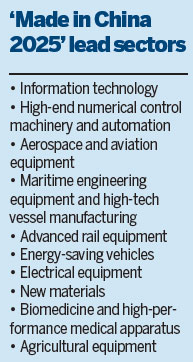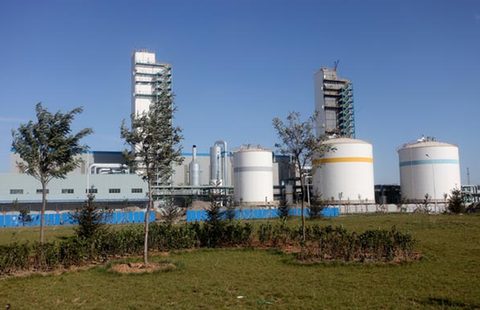Curtain rises on industry's way forward
Updated: 2015-03-26 07:32
By Zhao Yinan(China Daily)
|
|||||||||
Ten key sectors backed by govt to transform China into a competitive player on global stage
China's ambitious plans to upgrade its manufacturing power in the next 10 years were unveiled at a meeting of the State Council on Wednesday.
Chaired by Premier Li Keqiang, an executive meeting of the council announced that government support, including special funding and tax incentives, will focus on 10 industrial sectors capable of transforming the nation into a more competitive player globally.
The program, "Made in China 2025", was first mentioned by Li in his Government Work Report to lawmakers at the annual session of the National People's Congress at the start of this month.
The program is viewed by Chinese economists and industrial leaders as the nation's answer to "Industry 4.0", a concept about the future for industry that was first featured in a German government high-tech strategy in 2013.
In a statement released after Wednesday's meeting, the government demanded "concrete results in key fields".
It called for greener, more intelligent manufacturing, with an emphasis on quality and adapting well to the trend of being increasingly integrated with the Internet.
The government said it will draw up a list to include industrial sectors that will be given development priority, stating how they can be upgraded further. The list will be subject to adjustment if required.

The meeting described China's industrialization as "uncompleted", with manufacturing industry remaining the foundation of the economy.
The initiative to upgrade the nation from a big manufacturer to a manufacturing industry superpower is key to helping China maintain economic growth at a medium-to-high level and to move up the global value chain.
China has become the world's second-largest economy by producing enormous amounts of consumer products and selling them overseas. But the days of double-digit growth in manufacturing output have gone, stemming from inefficient traditional methods and a lack of high-end manufacturing.
Domestic manufacturing fell to its lowest point in nearly a year this month, according to the HSBC flash manufacturing Purchasing Managers Index.
Debate on whether China had lost its edge in manufacturing was triggered after media reports said Chinese customers were flocking to Japan for locally made toilet seat covers and electrical rice cookers.
Chen Yao, director of the Institute of Industrial Economics at the Chinese Academy of Social Sciences, said China is a large manufacturing country, but not a manufacturing superpower because it lacks core technologies.
But Chen said the nation still holds an advantage as it has an established infrastructure to allow industrial manufacturing to boom.
Lin Zuoming, chairman of the Aviation Industry Corp of China, said this month during the two sessions - the country's annual legislative meetings - that China's plan to upgrade its industrial structure is challenged by an enormous shortage of highly skilled workers.
zhaoyinan@chinadaily.com.cn

 Top 10 steel producers in China
Top 10 steel producers in China
 Highlights of China Fashion Week
Highlights of China Fashion Week Cockpit mystery emerges
Cockpit mystery emerges
 ISU figure skating worlds opens in Shanghai
ISU figure skating worlds opens in Shanghai
 Canola flowers form the emblem of harmony
Canola flowers form the emblem of harmony
 Your city in the shape of tiny round planet
Your city in the shape of tiny round planet
 Families mourn victims of Airbus A320 crash
Families mourn victims of Airbus A320 crash
 38,000 Brazilian troops to safeguard 2016 Rio Olympics
38,000 Brazilian troops to safeguard 2016 Rio Olympics
Most Viewed
Editor's Picks

|

|

|

|

|

|
Today's Top News
Apple Pay would face battle in China: Analysts
Michigan firm gets $1 billion Chinese contract
Teen's DNA project nets student Intel science award
China, US bear down on fugitives, 'Sky Net' unleashed
Analysts: US urged to not politicize bank
Germanwings' co-pilot 100 percent fit to fly: Lufthansa CEO
Yuan backed on Silk Road
RMB hub makes a splash
US Weekly

|

|








